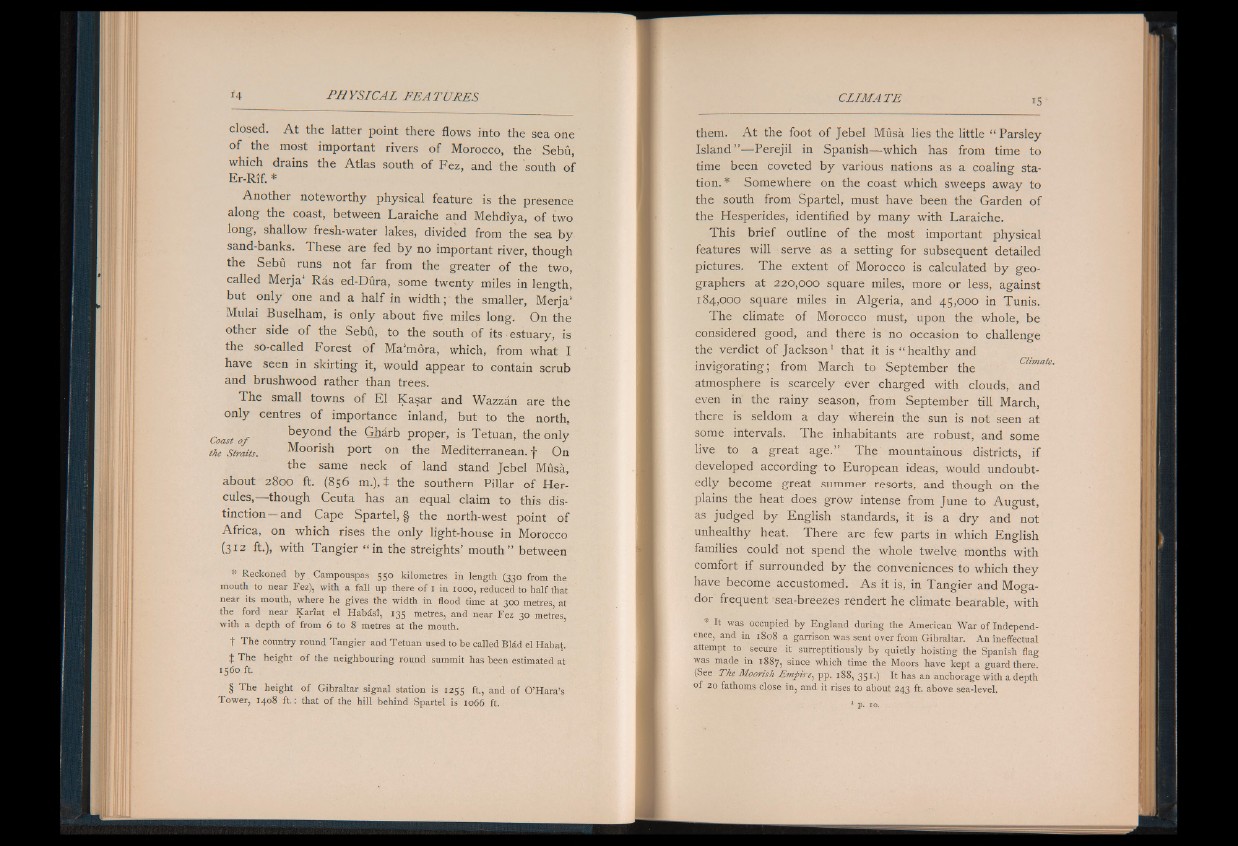
closed. A t the latter point there flows into the sea one
o f the most important rivers o f Morocco, the Sebu,
which drains the Atlas south of Fez, and the south of
Er-Rif. *
Another noteworthy physical feature is the presence
along the coast, between Laraiche and Mehdiya, of two
long, shallow fresh-water lakes, divided from the sea by
sand-banks. These are fed by no important river, though
the Sebu runs not far from the greater of the two,
called Merja1 Ras ed-Dura, some twenty miles in length,
but only one and a half in width; the smaller, Merja1
Mulai Buselham, is only about five miles long. On the
other side o f the Sebu, to the south o f its ■ estuary, is
the so-called Forest o f Ma'mora, which, from what I
have seen in skirting it, would appear to contain scrub
and brushwood rather than trees.
The small towns of El Kasar and Wazzan are the
only centres o f importance inland, but to the north,
Coast o f beyond the Gharb proper, is Tetuan, the only
the Straits. Moorish port on the Mediterranean, f On
the same neck of land stand Jebel Musa,
about 2800 ft. (856 m.),t the southern Pillar of Hercules,—
though Ceuta has an equal claim to this distinction—
and Cape Spartel, § the north-west point of
Africa, on which rises the only light-house in Morocco
(312 ft.), with Tangier “ in the streights’ mouth” between
* Reckoned by Campouspas 550 kilometres in length (330 from the
mouth to near Fez), with a fall up there of 1 in 1000, reduced to half that
near its mouth, where he gives the width in flood time at 300 metres at
the ford near Kariat el Habasi, 135 metres, and near Fez 30 metres
with a depth of from 6 to 8 metres at the mouth.
f The country round Tangier and Tetuan used to be called Blad el Habat.
4 The height of the neighbouring round summit has been estimated at
1560 ft.
§ The height of Gibraltar signal station is 1255 ft., and of O’Hara’s
Tower, 1408 ft.: that of the hill behind Spartel is 1066 ft.
them. A t the foot of Jebel Musa lies the little “ Parsley
Island”— Perejil in Spanish— which has from time to
time been coveted by various nations as a coaling station.
* Somewhere on the coast which sweeps away to
the south from Spartel, must have been the Garden of
the Hesperides, identified by many with Laraiche.
This brief outline of the most important physical
features will serve as a setting for subsequent detailed
pictures. The extent of Morocco is calculated by geographers
at 220,000 square miles, more or less, against
184,000 square miles in Algeria, and 45,000 in Tunis.
The climate of Morocco must, upon the whole, be
considered good, and there is no occasion to challenge
the verdict of Jackson1 that it is “ healthy and
invigorating; from March to September the
atmosphere is scarcely ever charged with clouds, and
even in' the rainy season, from September till March,
there is seldom a day wherein the sun is not seen at
some intervals. The inhabitants are robust, and some
live to a great age.” The mountainous districts, if
developed according to European ideas, would undoubtedly
become great summer resorts, and though on the
plains the heat does grow intense from June to August,
as judged by English standards, it is a dry and not
unhealthy heat. There are few parts in which English
families could not spend the whole twelve months with
comfort if surrounded by the conveniences to which they
have become accustomed. A s it is, in Tangier and Moga-
dor frequent sea-breezes rendert he climate bearable, with
* It was occupied by England during the American War of Independence,
and in 1808 a garrison was sent over from Gibraltar. An ineffectual
attempt to secure it surreptitiously by quietly hoisting the Spanish flag
was made in 1887, since which time the Moors have kept a guard there.
(See The Moorish Empire, pp. 188, 351.) It has an anchorage with a depth
of 20 fathoms close in, and it rises to about 243 ft. above sea-level.
1 p . IO.